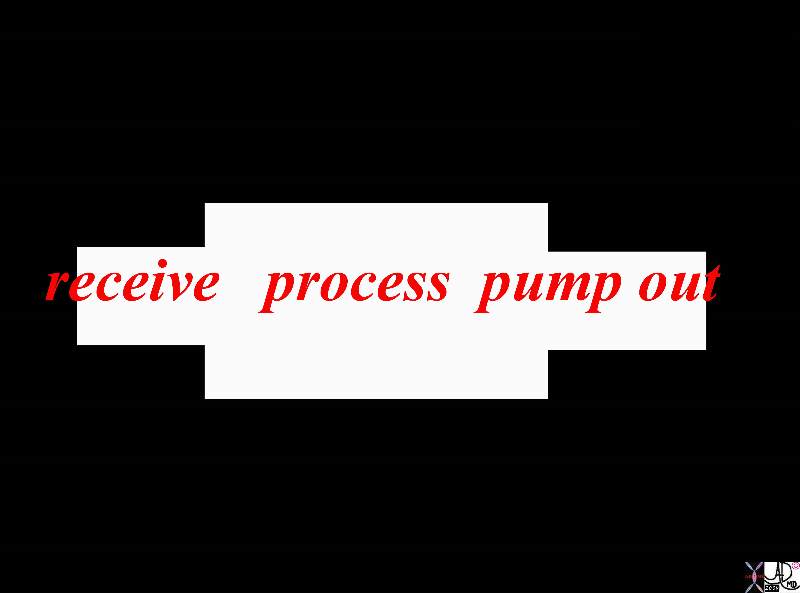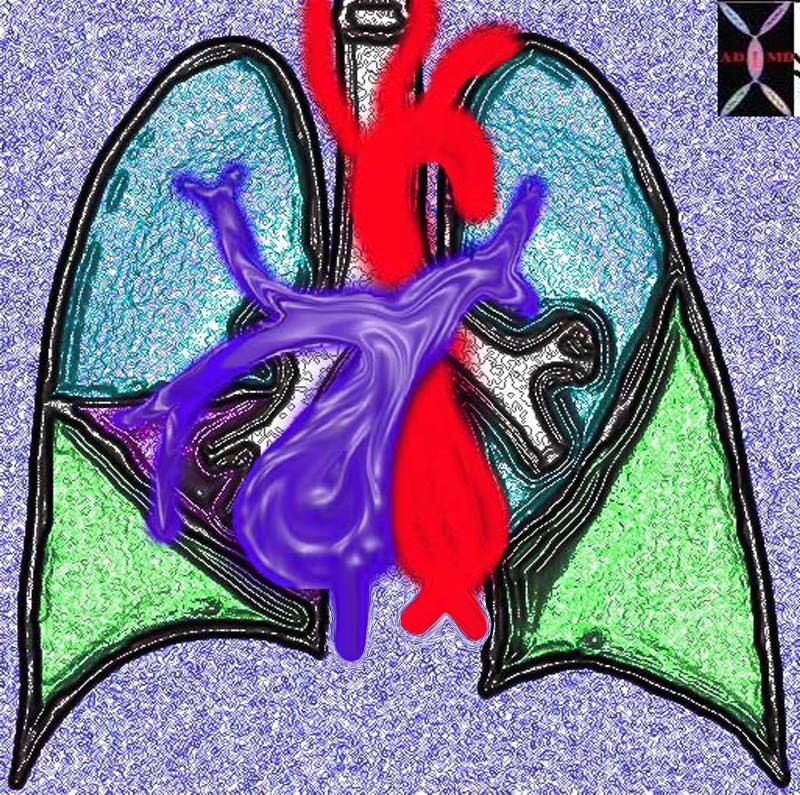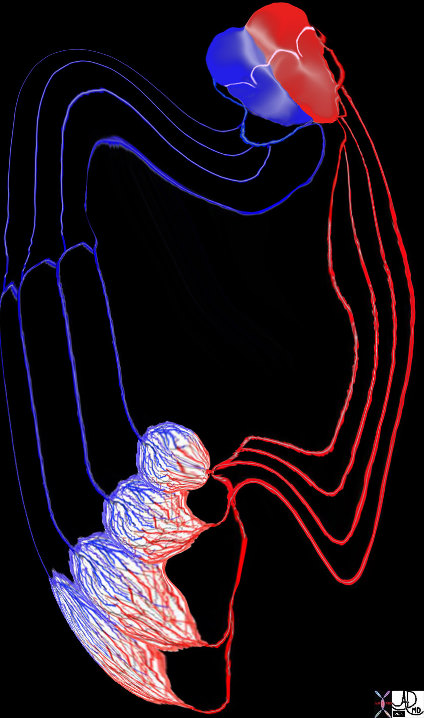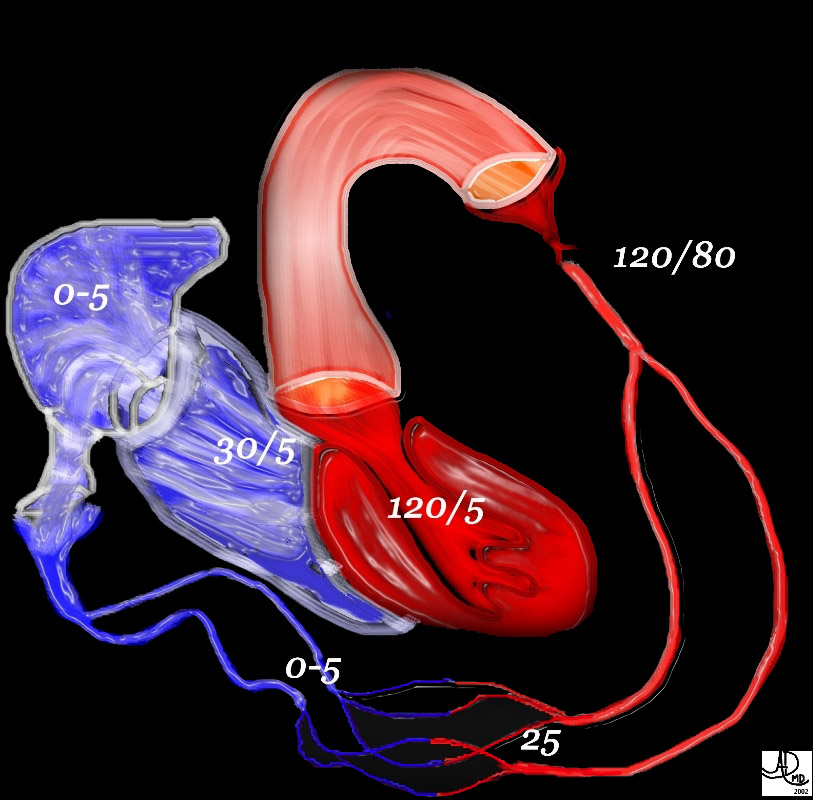The Heart as a Pump
Copyright 2009
Pump
Starting with the Most Basic of Principles
All functional devices work on the principal that they receive process and export.
A pump is a mechanical device that moves gases or fluids. In order for a pump to be effective it must pump out what it receives.

Principles of Function
The heart is a functional structure and therefore it conforms to the principles of all other functional structures. In keeping with these principles it therefore receives a product, processes it and then exports the product. In the case of the heart, it receives blood, accumulates an adequate volume while it relaxes and then gathers forces to export it by contraction.
86814.8s Courtesy Ashley Davidoff
In order for the heart to be effective in the body it needs to pump out what the body needs and able to receive what is returned to it.
The heart is a positive displacement pump meaning that it causes the blood to move by first trapping a fixed amount of blood in the chambers, and then forcing the blood into the outflow system by contraction. It accomplishes this by a reciprocal motion of relaxation and contraction. The pumping chamber reduces its volume by muscular contraction, while the receiving chamber increases its volume by relaxation. The contraction forces the blood to move forward, and the relaxation creates a relative vacuum allowing blood to be sucked into the heart.
The heart consists of two such pumps that are connected in series allowing for a pulmonary circulation and a left sided systemic circulation

Systemic Circulation and Pulmonary Circulation
This diagram shows the right ventricle and lobar pulmonary arteries in blue and the left ventricle and aorta in red. The right sided component of the pump (blue) receives blood from the systemic circulation via the SVC and IVC, pumps it to the lungs. The left sided circulation (red) receives oxygenated blood and pumps it to the systemic circulation.
Note that the lobar pulmonary arteries have the same irregular dichotomous branching pattern as the lobar bronchi and give 3 major branches to the right lung (RUL, RML and RLL arteries) and two to the left (LUL and LLL pulmonary arteries). As you will see and learn later, even the position and direction of the main pulmonary arteries in relation to the main stem bronchi are asymmetrical.
Courtesy Ashley Davidoff MD 32687b02.15k.8s Davidoff art

The pump is enabled by the contractile properties of the myocardium. In this diagram a single contraction is demonstrated, forcing the blood through the aortic valve, (not shown) into the aorta, against the resistance or afterload of the systemic circulation which allows the generation of the pressure. The force generated causes blood to flow from a high pressure proximally to a low pressure in the capillaries.
72839 Davidoff Art Courtesy Ashley Davidoff MD 72835.800 72839 72831.800 72845.800 49483b01

The heart is is intimately connected to all the tissues and cells of the body from the tip of the toes to the crown of the head.. The systemic arterial connection originates from the aorta with connections via the brachiocephalic, mesenteric, renal and peripheral arterial systems. The systemic veins join to form the inferior vena cava that drains the lower part of the body and superior vena cava that drains the upper part. The lymphatic system flows from the heart into the thoracic and right lymphatic ducts. The nerve supply is via connections to the sympathetic (celiac axis) and parasympathetic (vagus) systems. Hormonal connections include interaction with epinephrine, nor epinephrine, and thyroid hormones, but the atrial muscles also produce hormones for example atrial natriuretic peptide (ANP) that is responsible for homeostasis of water sodium potassium and adipose tissue.
Ashley Davidoff MD
32368b05.800

Note the difference in the pressures between the left side of the circulation and the right. The left ventricular pressure reaches a systolic of 120 mmHg, while the right atrial pressure is close to zero. This large difference allows blood to flow through the circulation. pressure principles
49483b01 Davidoff MD Davidoff art
The power added to the fluid flow by the pump (Po), is defined using SI units by:
PO is = ? is the fluid density (kg/m3) X g is the gravitational constant (9.81 m/s2) X H is the energy Head added to the flow (m) X Qis the flow rate (m3/s)
where:
- PO is the output power of the pump (W)
- ? is the fluid density (kg/m3)
- g is the gravitational constant (9.81 m/s2)
- H is the energy Head added to the flow (m)
- Q is the flow rate (m3/s)
Power is more commonly expressed as kW (103 W) or horsepower (multiply kW by 0.746), H is equivalent to the pressure head added by the pump when the suction and discharge pipes are of the same diameter. The power required to drive the pump is determined by dividing the output power by the pump efficiency
The Heart
In an average lifetime, the heart beats more than two and a half billion times. Think about this number a few times – imagine what an unbelievable engineering feat nature has accomplished. In fact it is not just a pump that pumps in and out. There is second to second, and beat to beat variation so that it continuously changes its patterns of contraction and relaxation, always accommodating bodily needs. The heart circulates the body’s blood supply about 1,000 times each day, circulating 5-6000 litres of blood through 62,000 miles (length of two and half times around the earth). An average adult body contains about five liters of blood.
The beat to beat to beat variation allows the output from the left to be reconciled with what is coming back in the return, so that congestion does not occur. In addition physiology is a dynamic process and the demands of each system in the body changes based on special needs and activities. The heart also has to accomodate to these changing needs distributing a fixed amount of blood to the regions that need it most at any one time. During excercise for example the skeletal muscle is in great demand, while the gastrointestinal system is quiet. Blood has to be shunted from the one to the other. The controlling mechanisms at both the local and systemic levels are simply elegant, complex, but effective.
References
